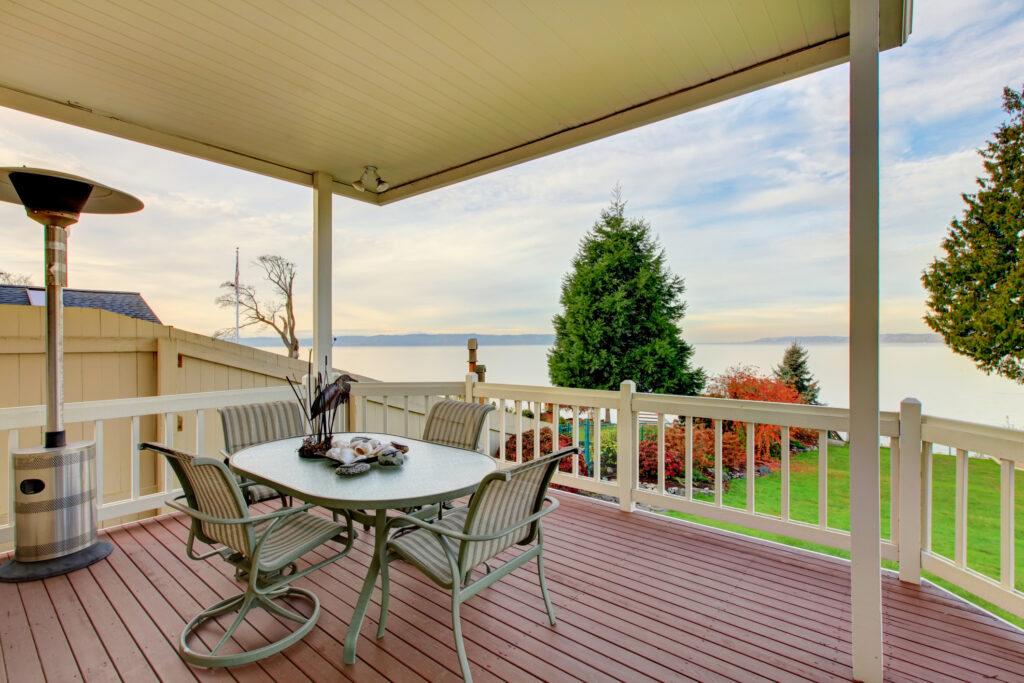
Musing the Material
Designing an eco-friendly and sustainable deck is easier than you would think. The first thing to contemplate is material choices for your deck. If you are building a wood deck, both ipê (also known as handroanthus) and bamboo are excellent choices but are more expensive. You could check out using wood that is native to your local area. That way, you’re not only supporting local forestry but also cutting down on emissions. Another great resource is the Forest Stewardship Council or the FSC. The FSC advocates responsible practices in the way of sourcing wood for projects like decks, in building carpentry construction, and even in the process of making paper.
Materials such as aluminum or PVC are also sustainable choices. Aluminum tends to get hot in the summer, so aluminum may not be your top pick if you live in a hot and sunny climate. PVC, or polyvinyl chloride, on the other hand, is made from recycled plastic with no wood fiber.
Another consideration is building a composite deck. Trex is one of the largest suppliers of composite materials. With many decking options, various beautiful colors, and multiple resources, Trex is a terrific choice for composite decking. The material is low maintenance, durable, and it can withstand many different types of weather, including humidity, harsh cold, and high heat. With a bit of routine yearly maintenance, this type of deck will continue to look good and last a very long time.

Awesome water view from the covered wooden deck with white railings. Luxury two story house exterior. Northwest, USA
Deciding the Design
So now you’ve chosen the decking material, and you want to consider placing your deck in the best and most favorable backyard area. Consider where most of the sunlight will hit, what type of deck privacy you want, and the activities you will enjoy on your deck. If you are more of a sun worshipper, then peak sunlight hours will influence where your deck is situated. If you like to simply hang out and relax in your hideaway, think about a sight (and potentially a sound) barrier to shield you from your neighbors. Lastly, if you’re thinking about entertaining or outdoor fun and games, ensure your deck design reflects that. Don’t forget you can utilize natural features of your yard, such as hedges or trees, to help with any privacy concerns or aesthetics.
If you’re incorporating other backyard features, like a fire pit, pool, or grilling area, set up your deck to have a safe place away from the heat of the grill or fire pit/chiminea – and a respite from the pool. Fortunately, with most deck designs, it’s very easy to section off the activity area from the sitting area. This works especially well if you also have a patio.
Solar lights are a great option if you are considering lighting your garden and deck area. Light your pathways, stairs, and the border of your deck. This makes it safer and will make your deck attractive in the nighttime hours.
Dealing with Drainage
A couple of points to note: if you have a second-story deck, contemplate ways to make the space under your deck water-resistant. Additionally, you want to filter rainwater away from your deck and patio. This is very important if you live in a wet climate. Sustainable choices include river rocks, stone, and possibly a French drainage pipe. This is a perforated drain pipe set in gravel. It will guide water away from your yard and let it flow away from your house and deck.
Installing flashing tape, like butyl tape, will help keep the underside of your deck dry. It also aids in keeping your deck’s substructure mold resistant. If you plan on using the space under your deck to construct an area for entertainment, meditation, or relaxation, consider an under-deck drainage system. Trex RainEscape is an easy-to-install system of channels and gutters under your deck to divert moisture away. Trex RainEscape comes with a 25-year warranty. Now you can sit back and enjoy the peaceful serenity of your deck’s shelter.
Waterproofing your deck, no matter the material, is critical so you don’t have mildew, which can ultimately rot your deck’s substructure. In addition, you want to enjoy your outdoor area for a long time without worrying about damage from water and moisture.
Loving the Lifestyle
We’ve talked about decking materials, design, and drainage. Now onto the fun stuff – décor! How can you keep your deck ecologically responsible with a sustainable setup? Try using eco-friendly furniture, intelligent landscaping, and take advantage of some of nature’s wonderful features.
Pick out sustainable deck furnishings; use recycled or repurposed furniture, if possible. Wooden pallets are an exciting and enterprising addition to your outdoor seating arrangement. Get creative with fabric, as well. Plenty of patterns and textures do well outside – and are eye-catching.
Regarding landscaping, it’s possible to set it up so it’s advantageous in more ways than one. Lush plants will not only be a striking and beautiful addition, but they’ll bring in oxygen and pollinators to help the ecosystem. Plants also provide shade and a natural boundary to get some privacy away from your neighbor’s gaze. Trees and bushes are an appealing nature-made border ideal for accentuating your backyard, patio, and deck space.
In Conclusion:
We love spending time outside, and decks give us so much flexibility! Building a sustainable outdoor living space is smart and beneficial to your lifestyle. Not only does it help the environment, but you’re leading the way for future generations to appreciate nature the way you do.
